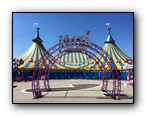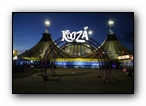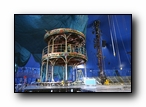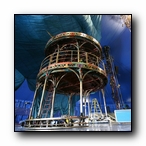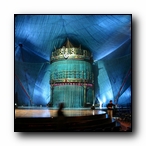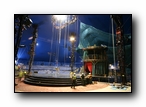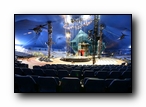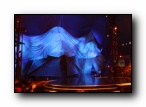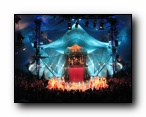
![]()
[ You are here: Grand Chapiteau | Creations | Koozå | Scénographie ]
Création
Expérience
RéserveRetiré
Odyssey
The structure of the acrobats skeletons and muscles are not the only structures contributing to the uniqueness of this production – there is another, much less flexible, series of structures at work: the staging and grandstand assembly. The staging and grandstand requirements for a touring Cirque du Soleil show are quite naturally rigorous. These structures must not only be extremely rigid and offer high load-bearing capactities, but they must also be easily set up and torn down for touring. However wonderful these structural solutions seem, the real wonder and elegance of Kooza happens on and above the stage.
As with all staging types, the touring stage for Kooza must bear a uniformly distributed load of a minimum of 125 pounds per square foot and meet code requirements for lateral loads. The point-load requirement of 1,500 pounds on a 2-inch diameter with a maximum deflection of 3/8-inch is called for because of acrobatic numbers that require supporting in an extremely rigid manner. Lastly, the stage must also bear tension loads from the cables that are used to stabilize the high wire acts and other aerial numbers. Tension loads from 300 pounds to 1000 pounds must be able to be anchored to the decking and sub-structure of the stage in almost any location since the configuration of acts could change over the run of the show. The Open Shell Trust (OST) staging system developed by Scène Éthique (SE) meets these needs while still offering a simple and quick assembly of the stage. The OST system uses a highly structural upper member to which the deck panels are fixed with a quick release system. This places all of the structural elements required to meet Kooza’s specification directly under the panels, therefore leaving the underside of the stage free of cross bracing. The OST also allows for legs to be spread out on 8- to 10-foot centers keeping the underside of the stage very clear, allowing for the unhindered movement of the acrobats and clowns so that they can appear from traps located throughout the stage. Kooza's set evokes a public square that metamorphoses into a circus ring. The circular stage provides the audience with excellent sight lines through 260 degrees. There has been no attempt to conceal or disguise the acrobatic equipment. The structure of the big top is always in full view. Everything is done out in the open with simplicity and transparency in order to concentrate the audience’s attention on the artists and the acrobatic performances.
Overlooking the Bataclan, the giant fabric structure called the Void, was printed with motifs inspired by the internal structure of leaves to give it a decidedly organic look. The “sails” that frame the Bataclan can be opened and closed like the petals of an enormous flower by just two people using ropes and pulleys. The surface of the stage is decorated to look like a starry sky, and in the center ring is a graphic representation of the sky in Montreal on the night of the first public performance. The stage is ringed by recessed lighting units that cast a warm glow onto the faces of the performers, much like the footlights of a 19th-century theatre.
Kooza’s eclectic musical score blends elements of hip hop, funk, ethnic, and classical music, all powerfully presented by sound co-designers Jonathan Deans and Leon Rothenberg through an elaborate Meyer Sound self-powered loudspeaker system.Deans, the sound designer for numerous Cirque du Soleil shows, and Rothenberg, who served as his assistant on several productions, collaborated equally on the vibrant sound design for Kooza. This is the first time Rothenberg has shared duties with Deans on a Cirque du Soleil production. The Meyer Sound loudspeaker system, provided by Montreal-basedSolotech, features 12 M’elodie ultra-compact high-power curvilinear array loudspeakers and 14 M1D ultra-compact curvilinear array loudspeakers, with additional Meyer Sound components strategically located to add specific ambience and dimension to the mix. “One of the great things about Meyer Sound speakers is that their specifications on paper are exactly the same as what we get in the theatre,” says Rothenberg. “It allows us to get very exacting when aiming the sound.” The Grand Chapiteau, a purpose-built venue made of thick, highly reflective plastic-treated canvas, posed a particular challenge when mixing the audio, as did changes in humidity, temperature, and venue location. “What acoustics you do get from the tent are mainly extreme amounts of high end, while the low end goes right out,” says Deans. The sound system also employs Meyer Sound’s LCS Series Matrix3 audio show control system, paired with both the CueMixer compact and CueConsole modular control surfaces, to create an innovative spatial aspect for every seat in the house. “Using the LCS Series products, we’re able to blend perspectives to create an experience that sounds like nothing you’ve ever heard before in a tent,” Rothenberg continues. “No other system gives you the flexibility to make those kinds of choices. The LCS Series technology allows us to access every speaker directly, all of the time.” |


